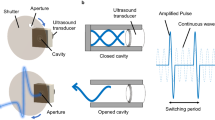Abstract
The laser ultrasonic technique in the ablation regime was studied for the effective excitation of ultrasound. First, the optimal laser beam intensity to maximize the amplitude of ultrasound was obtained. This is useful because the amplitude of ultrasound does not always increase as the laser beam intensity increases due to the plasma shielding effect. When the laser energy is fixed, for a steel specimen, the maximum ultrasonic amplitude is obtained at the laser beam intensity in the range of 10–20 GW/cm2. In addition, an inline method to obtain the optimal laser beam intensity was proposed based on the phenomena that the amplitude of the air-borne sound induced by plasma is inversely proportional to the amplitude of the generated ultrasound. Experimental results verified the usefulness of the proposed method by showing that the amplitude of ultrasound reached its maximum when the plasma-induced airborne sound disappeared.
Similar content being viewed by others
References
Scruby, C. B. and Drain, L. E., “Laser Ultrasonics Techniques and Applications,” CRC Press, pp. 242–250, 1990.
Green, R. E., “Non-Contact Ultrasonic Techniques,” Ultrasonics, Vol. 42, No. 1, pp. 9–16, 2004.
Yan, Z. and Nagy, P. B., “Thermo-Optical Modulation of Ultrasonic Surface Waves for NDE,” Ultrasonics, Vol. 40, No. 1, pp. 689–696, 2002.
Davies, S. J., Edwards, C., Taylor, G. S., and Palmer, S. B., “Laser- Generated Ultrasound: Its Properties, Mechanisms and Multifarious Applications,” Journal of Physics D: Applied Physics, Vol. 26, No. 3, pp. 329–348, 1993.
Murray, T. W. and Wagner, J. W., “Laser Generation of Acoustic Waves in the Ablative Regime,” Journal of Applied Physics, Vol. 85, No. 4, pp. 2031–2040, 1999.
Bulgakova, N. M. and Bulgakov, A. V., “Pulsed Laser Ablation of Solids: Transition from Normal Vaporization to Phase Explosion,” Applied Physics A, Vol. 73, No. 2, pp. 199–208, 2001.
Seo, H., Jhang, K.-Y., Kim, K.-C., and Hong, D.-P., “Improvement of Crack Sizing Performance by using Nonlinear Ultrasonic Technique,” Int. J. Precis. Eng. Manuf., Vol. 15, No. 11, pp. 2461–2464, 2014.
Hrovatin, R. and Možina, J., “Effect of Plasma Shielding in Laser Ultrasonics: Optoacoustic Characterization,” Journal of Applied Physics, Vol. 75, No. 12, pp. 8207–8209, 1994.
Hrovatin, R. and Možina, J., “Optodynamic Aspect of a Pulsed Laser Ablation Process,” Applied Surface Science, Vol. 86, No. 1, pp. 213–218, 1995.
Guo, B., Zhao, Q., and Yu, X., “Surface Micro-Structuring of Coarse-Grained Diamond Wheels by Nanosecond Pulsed Laser for Improving Grinding Performance,” Int. J. Precis. Eng. Manuf., Vol. 15, No. 10, pp. 2025–2030, 2014.
Ho, C.-C. and He, J.-J., “On-Line Monitoring of Laser-Drilling Process based on Coaxial Machine Vision,” Int. J. Precis. Eng. Manuf., Vol. 15, No. 4, pp. 671–678, 2014.
Dixon, S., Burrows, S. E., Dutton, B., and Fan, Y., “Detection of Cracks in Metal Sheets using Pulsed Laser Generated Ultrasound and Emat Detection,” Ultrasonics, Vol. 51, No. 1, pp. 7–16, 2011.
Baac, H. W., Ok, J. G., Lee, T., and Guo, L. J., “Nano-Structural Characteristics of Carbon Nanotube–Polymer Composite Films for High-Amplitude Optoacoustic Generation,” Nanoscale, Vol. 7, No. 34, pp. 14460–14468, 2015.
O'Donnell, M., Hou, Y., Kim, J.-S., Ashkenazi, S., Huang, S.-W., and Guo, L., “Optoacoustic Generation of High Frequency Sound for 3-D Ultrasonic Imaging in Medicine,” The European Physical Journal Special Topics, Vol. 153, No. 1, pp. 53–58, 2008.
Boulmer-Leborgne, C., Hermann, J., and Dubreuil, B., “Plasma Formation Resulting from the Interaction of a Laser Beam with a Solid Metal Target in an Ambient Gas,” Plasma Sources Science and Technology, Vol. 2, No. 3, pp. 219–226, 1993.
Lewis, G. K. and Dixon, R. D., “Plasma Monitoring of Laser Beam Welds,” Welding Research Supplement, Vol. 64, pp. 49s–54s, 1985.
Ushio, M., Komurasaki, K., Kawamura, K., and Arakawa, Y., “Effect of Laser Supported Detonation Wave Confinement on Termination Conditions,” Shock Waves, Vol. 18, No. 1, pp. 35–39, 2008.
Amer, E., Gren, P., and Sjödahl, M., “Shock Wave Generation in Laser Ablation Studied using Pulsed Digital Holographic Interferometry,” Journal of Physics D: Applied Physics, Vol. 41, No. 21, Paper No. 215502, 2008.
Author information
Authors and Affiliations
Corresponding author
Rights and permissions
About this article
Cite this article
Seo, H., Kim, JG., Yoon, S. et al. Determination of laser beam intensity to maximize amplitude of ultrasound generated in ablation regime via monitoring plasma-induced air-borne sound. Int. J. Precis. Eng. Manuf. 16, 2641–2645 (2015). https://doi.org/10.1007/s12541-015-0338-0
Received:
Revised:
Accepted:
Published:
Issue Date:
DOI: https://doi.org/10.1007/s12541-015-0338-0



